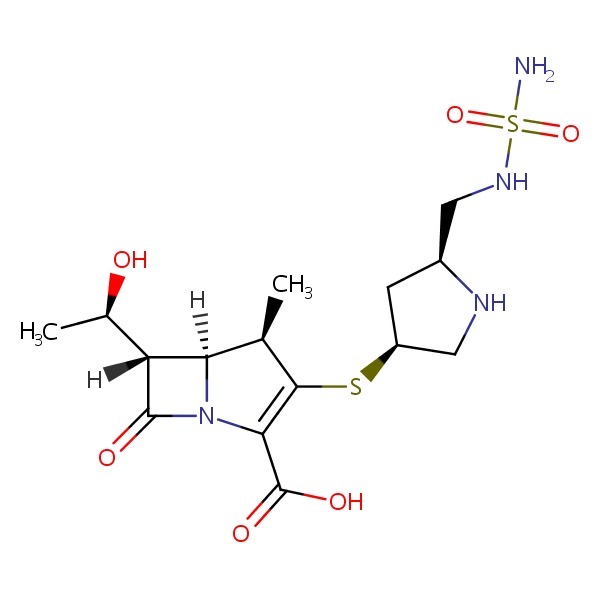NCBI Bookshelf. A service of the National Library of Medicine, National Institutes of Health.
LiverTox: Clinical and Research Information on Drug-Induced Liver Injury [Internet]. Bethesda (MD): National Institute of Diabetes and Digestive and Kidney Diseases; 2012-.

LiverTox: Clinical and Research Information on Drug-Induced Liver Injury [Internet].
Show detailsOVERVIEW
Introduction
Doripenem is a broad spectrum carbapenem antibiotic used primarily for the treatment of aerobic gram-negative bacterial infections. Doripenem, like other carbapenems, is associated with transient and asymptomatic elevations in serum enzymes. The carbapenems have also been linked to rare instances of clinically apparent, acute cholestatic liver injury.
Background
Doripenem (dor" i pen' em) is a broad spectrum beta-lactam antibiotic used predominantly for treatment of severe aerobic gram-negative bacterial infections. Doripenem, like other carbapenems, binds to bacterial penicillin binding proteins and interferes with bacterial cell wall integrity and synthesis. It is a broad spectrum antibiotic with activity against many aerobic and anaerobic gram-positive and gram-negative organisms, including Staphylococcus aureus, Streptococcus pyogenes, Streptococcus agalactiae, viridans group streptococci, Enterococcus faecalis, Pseudomonas aeruginosa, Escherichia coli, Proteus mirabilis, Bacteroides fragilis and Peptostreptococcus species. Doripenem is claimed to have more potent activity against Pseudomonas species than the other carbapenems. Doripenem was approved for use in the United States in 2008, and its use is restricted largely to serious infections in hospitalized patients. Doripenem is indicated for the treatment of severe or complicated intraabdominal, urinary tract and urogenital infections due to susceptible organisms. The recommended dosage is 500 mg given intravenously every 8 hours for 5 to 14 days. It is currently available as Doribax in vials of 250 and 500 mg as a sterile powder for reconstitution. The most common side effects of doripenem are infusion site pain and phlebitis, diarrhea, nausea, rash, pruritus and headache.
Hepatotoxicity
Mild, transient, asymptomatic elevations in serum aminotransferase levels occur in 1% to 5% of patients receiving parenteral doripenem for 5 to 14 days. These abnormalities are usually self-limited and asymptomatic and rarely above 5 times the upper limit of normal. In the limited period that it has been available, no cases of hepatitis with jaundice have been reported. Nevertheless, several instances of cholestatic jaundice arising during or shortly after therapy have been reported with other carbapenems. The latency to onset has been within 1 to 3 weeks and the pattern of enzyme elevations is usually cholestatic. Immunoallergic features can occur, but autoantibodies are rare. The course is usually self-limiting, but at least one case of vanishing bile duct syndrome related to a carbapenem has been reported. Doripenem and other carbapenems have not been linked to cases of acute liver failure.
Likelihood score: E* (unproven but suspected cause of liver injury).
Mechanism of Injury
The cause of the mild, transient serum enzyme elevations during doripenem therapy is not known. The cholestatic hepatitis attributed to the carbapenems is probably immunoallergic and resembles the rare clinically apparent liver injury that has been linked to penicillins and cephalosporins.
Outcome and Management
The liver injury due to the carbapenems is usually mild, asymptomatic and self-limited. Rarely, the carbapenems can cause a clinically apparent acute cholestatic hepatitis that is usually self-limiting and not requiring therapy or intervention. There is little information on possible cross sensitivity to liver injury among the different beta-lactam antibiotics, but patients with clinically apparent liver injury due to doripenem should probably avoid the other carbapenems.
References to the safety and potential hepatotoxicity of doripenem are given in the Overview section on Carbapenems.
Drug Class: Antiinfective Agents, Carbapenems
Other Drugs in the Subclass, Carbapenems: Ertapenem , Imipenem , Meropenem
PRODUCT INFORMATION
REPRESENTATIVE TRADE NAMES
Doripenem – Doribax®
DRUG CLASS
Antiinfective Agents
Product labeling at DailyMed, National Library of Medicine, NIH
CHEMICAL FORMULA AND STRUCTURE
| DRUG | CAS REGISTRY NO | MOLECULAR FORMULA | STRUCTURE |
|---|---|---|---|
| Doripenem | 148016-81-3 | C15-H24-N4-O6-S2 |
 |
- PubChem SubstanceRelated PubChem Substances
- Review Ertapenem.[LiverTox: Clinical and Researc...]Review Ertapenem.. LiverTox: Clinical and Research Information on Drug-Induced Liver Injury. 2012
- Review Doripenem monohydrate, a broad-spectrum carbapenem antibiotic.[Clin Ther. 2009]Review Doripenem monohydrate, a broad-spectrum carbapenem antibiotic.Matthews SJ, Lancaster JW. Clin Ther. 2009 Jan; 31(1):42-63.
- Review Comparative review of the carbapenems.[Drugs. 2007]Review Comparative review of the carbapenems.Zhanel GG, Wiebe R, Dilay L, Thomson K, Rubinstein E, Hoban DJ, Noreddin AM, Karlowsky JA. Drugs. 2007; 67(7):1027-52.
- In vitro activity of doripenem, a carbapenem for the treatment of challenging infections caused by gram-negative bacteria, against recent clinical isolates from the United States.[Antimicrob Agents Chemother. 2...]In vitro activity of doripenem, a carbapenem for the treatment of challenging infections caused by gram-negative bacteria, against recent clinical isolates from the United States.Pillar CM, Torres MK, Brown NP, Shah D, Sahm DF. Antimicrob Agents Chemother. 2008 Dec; 52(12):4388-99. Epub 2008 Sep 8.
- Review Doripenem: a new carbapenem antibiotic.[Am J Health Syst Pharm. 2010]Review Doripenem: a new carbapenem antibiotic.Chahine EB, Ferrill MJ, Poulakos MN. Am J Health Syst Pharm. 2010 Dec 1; 67(23):2015-24.
- Doripenem - LiverToxDoripenem - LiverTox
Your browsing activity is empty.
Activity recording is turned off.
See more...